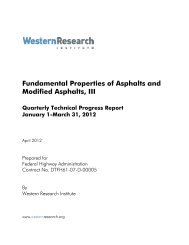Fundamental Properties of Asphalts and Modified Asphalts, III
Fundamental Properties of Asphalts and Modified Asphalts, III
Fundamental Properties of Asphalts and Modified Asphalts, III
You also want an ePaper? Increase the reach of your titles
YUMPU automatically turns print PDFs into web optimized ePapers that Google loves.
SUBTASK 2-2. AGING<br />
SUBTASK 2-2.1. IMPACT OF WATER ON AGING<br />
Statement <strong>of</strong> Problem<br />
The presence <strong>of</strong> moisture has been shown to increase the rate at which aging progresses in<br />
paving asphalts. Since aging ultimately leads to embrittlement <strong>and</strong> pavement failure,<br />
determining <strong>and</strong> modeling the influence <strong>of</strong> moisture is important to the prediction <strong>of</strong> pavement<br />
performance.<br />
Approach<br />
The sensitivity <strong>of</strong> asphalts to environmental factors is being determined using laboratory PAV<br />
aging tests on unmodified asphalts with <strong>and</strong> without moisture in the oven. Analytical tests<br />
applied include spectroscopic (FTIR) <strong>and</strong> rheologic (DSR) <strong>of</strong> the aged materials. Master curve<br />
<strong>and</strong> shift factors are used to quantify changes.<br />
Goal<br />
Develop relationships that predict the long-term aging <strong>of</strong> asphalts in the presence <strong>of</strong> moisture.<br />
Support <strong>of</strong> FHWA Strategic Goals<br />
The ability to reliably reproduce in the laboratory the aging that occurs in-sevice is vital to the<br />
highway community. With the development <strong>of</strong> a correlation between laboratory aging data <strong>and</strong><br />
field pavement performance, an agency may be able to predict the advent <strong>of</strong> distresses in the<br />
field, therefore, improving the cost effectiveness <strong>of</strong> the preventative maintenance <strong>and</strong>/or<br />
rehabilitation measures that are commonly used. This subtask supports the FHWA Strategic<br />
Goal <strong>of</strong> Optimizing Pavement Performance.<br />
Work Conducted This Quarter<br />
To evaluate the impact <strong>of</strong> moisture on the aging characteristics <strong>of</strong> asphalt binders in terms <strong>of</strong><br />
physical chemical relationships, previously collected data including the rheological <strong>and</strong> chemical<br />
properties <strong>of</strong> eight RTFO- <strong>and</strong> RTFO/PAV-aged SHRP asphalts were analyzed extensively. The<br />
RTFO-aged asphalts were PAV aged for different lengths <strong>of</strong> time in the absence <strong>and</strong> presence <strong>of</strong><br />
water. To further develop an underst<strong>and</strong>ing <strong>of</strong> the relationship between rheological properties<br />
<strong>and</strong> chemical properties mathematically, the complex modulus was plotted against carbonyl<br />
content for different aging times, 140, 240, <strong>and</strong> 480 hours for eight asphalts. The detailed results<br />
were presented in previous quarterly reports (December 31, 2007 <strong>and</strong> March 31, 2008). It was<br />
reported that both the complex modulus <strong>and</strong> carbonyl content increase with increasing aging<br />
time <strong>and</strong> that different asphalts have different sensitivities to aging. The complex modulus<br />
increases more sharply with increasing carbonyl content for some asphalts than for others. A<br />
statistical model, logistic with two parameters, was applied to describe the relationship. This<br />
equation is shown as follows:<br />
7





